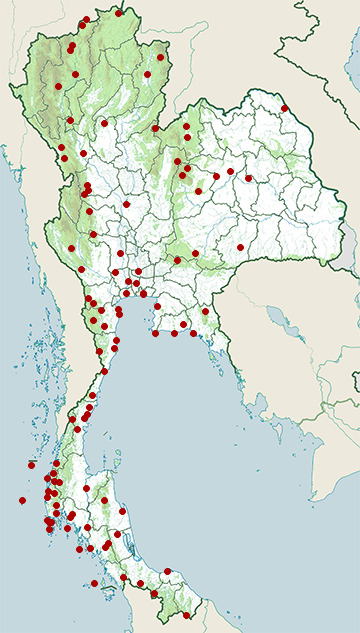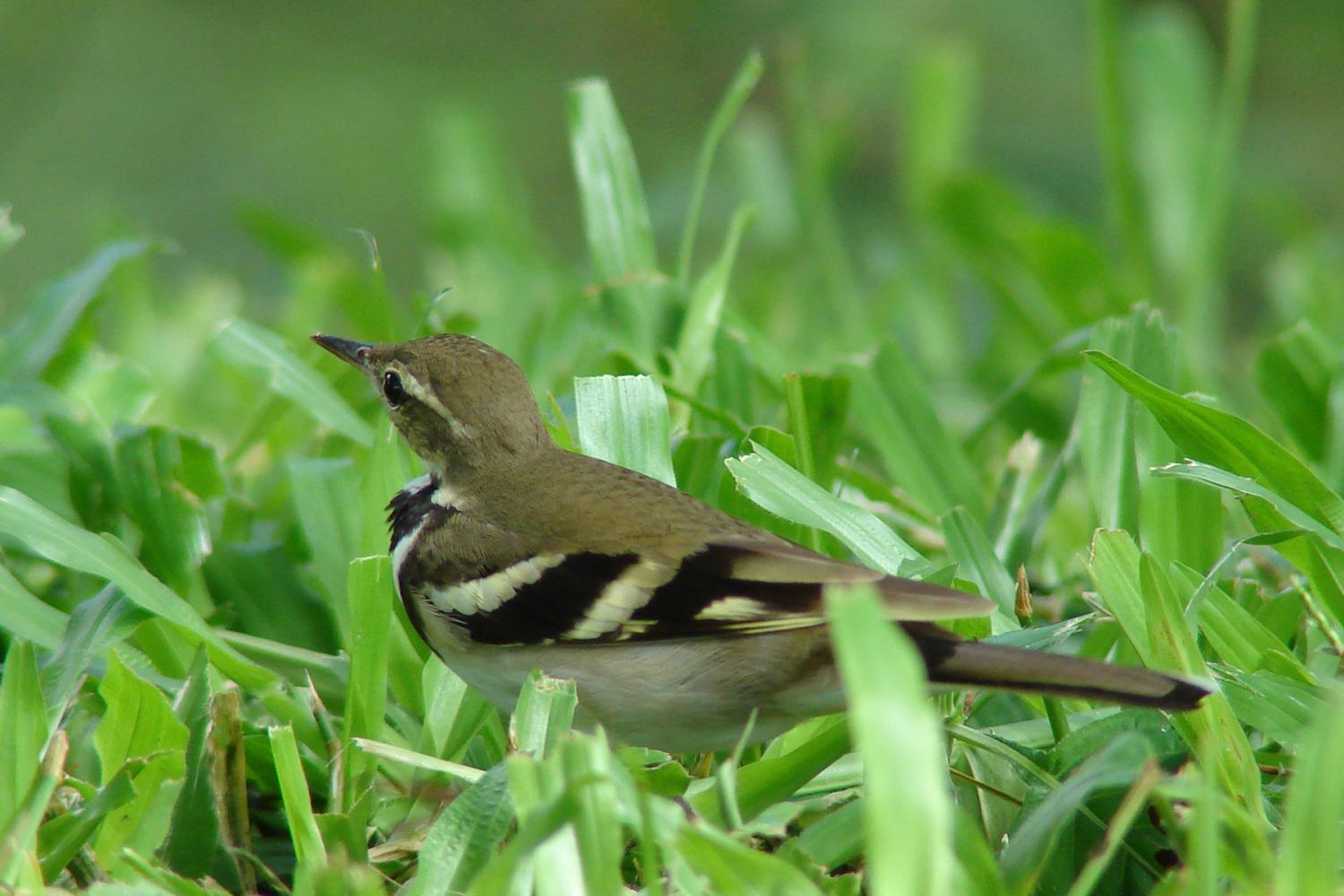Species of Thailand
Forest wagtail
Dendronanthus indicus
Johann Friedrich Gmelin, 1789
In Thai: นกเด้าลมดง
The forest wagtail (Dendronanthus indicus) is a medium-sized passerine bird in the wagtail family Motacillidae. It has a distinctive plumage that sets it apart from other wagtails and has the habit of wagging its tail sideways unlike the usual up and down movements of the other wagtail species. It is the only wagtail species that nests in trees. They are found mainly in forested habitats, breeding in the temperate parts of east Asia and wintering across tropical Asia from India to Indonesia.
Description
This is a distinctive wagtail, the only one placed in the genus Dendronanthus (all other wagtails are placed in Motacilla). The forest wagtail is 18 cm in length, a slender bird with a long tail. The back and crown are olive brown, and the wings are black with two yellow wing bars and white tertial edges. There is a white supercilium, above a dark stripe through the eye. The underparts are white, apart from a black double breast band. The upper breast band is bib-like while the lower band is often broken. Sexes are similar. Young birds are more yellowish on the underside.
Distribution and habitat
As its English and scientific names imply, this is a forest species, a distinction from all other wagtails. It is usually found in open areas of the woodland such as clearings. In winter it is found mainly in well-shaded forest habitats or along paths in coffee plantations and clearings in forests.
The breeding areas are in eastern Asia, parts of Korea, parts of China (Kansu, Anhwei, Hunan) and parts of Siberia. Southern records of breeding from Assam have been questioned. It migrates to the warmer parts of Asia in winter and it has been suggested that they reach southern India and Sri Lanka via the Andaman Islands. It has been recorded as a vagrant in the Maldives.
It was formerly thought to winter only in southwestern India, passing through the rest of the peninsula on migration. But now it has been shown to winter in all of the southern part of the peninsula in addition to southwestern India.
Behaviour and ecology
These wagtails are found singly or in small groups. They often forage in the trees and capture insects along the branches of trees. They may also forage on the ground like a pipit and when disturbed, it flies up into the trees with a sharp pink note. They roost in the company of other wagtails among reeds. The song includes disyllabic tsi-fee notes repeated several times. They can climb steep branches and will run rapidly along horizontal branches.
The breeding season is May in northeastern India and June in the Amur region. The forest wagtail leaves the winter quarters towards the end of March from Sri Lanka and mid March from the Malay Peninsula, the last birds leaving around May. During particularly cold springs, the arrival in the summer breeding grounds near the Kedrovaya River (Ussuri Land) can be as late as the end of May. Males sing from May to July, and when calling the bird sways at each syllable. It is the only wagtail that builds nests on trees, often favouring oaks. It builds its cup-shaped nest made up of fine grass and rootlets matted with moss and cobwebs. The nest is built by the female alone and the male stands guard nearby. The usual clutch is five eggs, incubated by the female alone for about 13 to 15 days. Incubation begins before the full clutch is laid and the eggs hatch at intervals. The young fledge and leave the nest after about 10 to 12 days. Both the males and females take part in feeding the young. Like other wagtails, this species is insectivorous.
Apart from its unusual plumage pattern and habitat, the forest wagtail differs from its Motacilla relatives in its strange habit of swaying its tail from side to side, not wagging it up and down like other wagtails. The Japanese name Jokofury-sekirei (=sideways-swinging wagtail) ) is based on this habit. In Sri Lanka, they often search for maggots in cattle dung and for this reason are known as gomarita (=dung-spreader).
The brown shrike (Lanius cristatus confusus) sometimes imitates the calls of the forest wagtail.
Voice
The forest wagtail has a single-note call (pink pink') given often while on the ground or even in high flight. In addition, the birds have a soft lilting song.
This article uses material from Wikipedia released under the Creative Commons Attribution-Share-Alike Licence 3.0. Eventual photos shown in this page may or may not be from Wikipedia, please see the license details for photos in photo by-lines.
Category / Seasonal Status
Wiki listed status (concerning Thai population): Winter visitor
BCST Category: Recorded in an apparently wild state within the last 50 years
BCST Seasonal status: Non-breeding visitor
Scientific classification
- Kingdom
- Animalia
- Phylum
- Chordata
- Class
- Aves
- Order
- Passeriformes
- Family
- Motacillidae
- Genus
- Dendronanthus
- Species
- Dendronanthus indicus
Common names
- Thai: นกเด้าลมดง
Synonyms
- Nemoricola indica
- Motacilla indica
- Limonidromus indicus
Conservation status

Least Concern (IUCN3.1)
Photos
Please help us review the bird photos if wrong ones are used. We can be reached via our contact us page.
Range Map

- Ao Phang-Nga National Park
- Bang Phra Non-Hunting Area
- Bang Pu Recreation Centre
- Bang Saphan Noi District, Prachuap Khiri Khan
- Bangkok Province
- Bueng Boraped Non-Hunting Area
- Chiang Dao District, Chiang Mai
- Chiang Dao Wildlife Sanctuary
- Doi Inthanon National Park
- Doi Lang
- Doi Pha Hom Pok National Park
- Doi Phu Kha National Park
- Hala-Bala Wildlife Sanctuary
- Hat Chao Mai National Park
- Hat Wanakon National Park
- Huai Kha Khaeng Wildlife Sanctuary
- Kaeng Krachan National Park
- Kaeng Som Maew Queen Sirikit Forest Park
- Kamphaeng Saen District, Nakhon Pathom
- Kantharawichai District, Maha Sarakham
- Kapong District, Phang Nga
- Khao Chong
- Khao Dinsor (Chumphon Raptor Center)
- Khao Laem Ya - Mu Ko Samet National Park
- Khao Lak - Lam Ru National Park
- Khao Luang National Park
- Khao Nam Khang National Park
- Khao Phanom Bencha National Park
- Khao Phra - Bang Khram Wildlife Sanctuary
- Khao Phra Thaeo Wildlife Sanctuary
- Khao Sam Roi Yot National Park
- Khao Soi Dao Wildlife Sanctuary
- Khao Sok National Park
- Khao Yai National Park
- Khlong Lan National Park
- Khlong Nakha Wildlife Sanctuary
- Khon San District, Chaiyaphum
- Khuan Khanun District, Phatthalung
- Khun Phawo National Park
- Khung Kraben Non-Hunting Area
- Khura Buri District, Phang Nga
- Klaeng District, Rayong
- Ko Lanta National Park
- Ko Phra Thong
- Kromluang Chumphon Wildlife Sanctuary
- Kui Buri National Park
- Laem Pak Bia
- Mae Ping National Park
- Mae Sot District, Tak
- Mae Wong National Park
- Mueang Chiang Mai District, Chiang Mai
- Mueang Khon Kaen District, Khon Kaen
- Mueang Krabi District, Krabi
- Mueang Loei District, Loei
- Mueang Nan District, Nan
- Mueang Pattani District, Pattani
- Mueang Phang Nga District, Phang Nga
- Mueang Phuket District, Phuket
- Mueang Samut Sakhon District, Samut Sakhon
- Mueang Suphanburi District, Suphan Buri
- Mueang Tak District, Tak
- Nam Nao National Park
- Nam Phong National Park
- Nong Bong Khai Non-Hunting Area
- Nong Thung Thong Non-Hunting Area
- Nong Ya Plong District, Phetchaburi
- Nong Yai Area Development Project Under Royal Init
- Pachee River Wildlife Sanctuary
- Pak Phanang District, Nakhon Si Thammarat
- Pak Thale
- Pang Sila Thong District, Kamphaeng Phet
- Pathio District, Chumphon
- Phi Phi Islands
- Phu Khiao Wildlife Sanctuary
- Phu Langka National Park
- Phu Suan Sai National Park
- Phu Toei National Park
- Phutthamonthon District, Nakhon Pathom
- Pran Buri Forest Park
- Sai Yok District, Kanchanaburi
- Sakaerat Environmental Research Station
- Samae San Island
- Samut Prakan Province
- San Kala Khiri National Park
- Sanam Bin Reservoir Non-Hunting Area
- Sawi District, Chumphon
- Si Satchanalai District, Sukhothai
- Similan Islands
- Sirinat National Park
- Sri Nakarin Dam National Park
- Sri Phang Nga National Park
- Surin Islands
- Takua Pa District, Phang Nga
- Tarutao National Marine Park
- Tat Ton National Park
- Tha Yang District, Phetchaburi
- Thalang District, Phuket
- Thale Ban National Park
- Wang Saphung District, Loei
- Wat Phai Lom & Wat Ampu Wararam Non-Hunting Area
- Yan Ta Khao District, Trang


